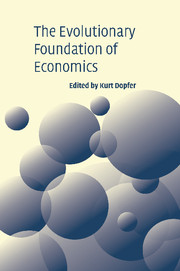Book contents
- Frontmatter
- Contents
- List of contributors
- List of figures
- List of tables
- Prolegomenon
- I Ontological foundations
- II A framework for evolutionary analysis
- 8 Towards an evolutionary theory of production
- 9 Learning in evolutionary environments
- 10 The evolutionary perspective on organizational change and the theory of the firm
- 11 The self-organizational perspective on economic evolution: a unifying paradigm
- 12 Evolutionary concepts in relation to evolutionary economics
- 13 Understanding social and economic systems as evolutionary complex systems
- 14 Perspectives on technological evolution
- 15 Evolutionary economic dynamics: persistent cycles, disruptive technology and the trade-off between stability and complexity
- 16 Evolutionary theorizing on economic growth
- Index of topics
- Index of names
- References
16 - Evolutionary theorizing on economic growth
Published online by Cambridge University Press: 22 September 2009
- Frontmatter
- Contents
- List of contributors
- List of figures
- List of tables
- Prolegomenon
- I Ontological foundations
- II A framework for evolutionary analysis
- 8 Towards an evolutionary theory of production
- 9 Learning in evolutionary environments
- 10 The evolutionary perspective on organizational change and the theory of the firm
- 11 The self-organizational perspective on economic evolution: a unifying paradigm
- 12 Evolutionary concepts in relation to evolutionary economics
- 13 Understanding social and economic systems as evolutionary complex systems
- 14 Perspectives on technological evolution
- 15 Evolutionary economic dynamics: persistent cycles, disruptive technology and the trade-off between stability and complexity
- 16 Evolutionary theorizing on economic growth
- Index of topics
- Index of names
- References
Summary
Introduction
While an evolutionary perspective has been urged upon economists since at least the time of Alfred Marshall (1890; see Hodgson, 1993, for a contemporary reiteration), what has been lacking until recently, at least for a large portion of the economics profession, has been a body of formal theory and quantitative analysis on an explicitly evolutionary basis. This has changed since the work of Richard Nelson and Sidney Winter in the 1960s and 1970s (summarized in Nelson and Winter, 1982), which operationalized and extended many of the concepts going back to Joseph Schumpeter (1934, 1942), Armen Alchian (1950), Jack Downie (1955), Josef Steindl (1952) and others. Since then a number of authors have been enlarging on this foundation and systematically extending the evolutionary economics paradigm in a number of directions. A survey of some of these can be found in Nelson, 1995.
In this chapter we intend to deal with the basics of a formal evolutionary approach to technical change, economic dynamics and growth. In so doing we will leave out for the most part the burgeoning new areas of application of evolutionary ideas to game theory, learning dynamics and bounded rationality, organization theory, financial markets, industrial organization and the interface between economics, law and culture – most of which are dealt with elsewhere in this volume.
- Type
- Chapter
- Information
- The Evolutionary Foundations of Economics , pp. 506 - 539Publisher: Cambridge University PressPrint publication year: 2005
References
- 26
- Cited by



